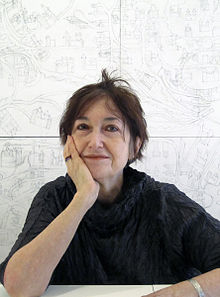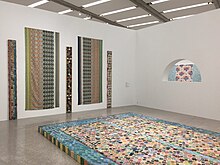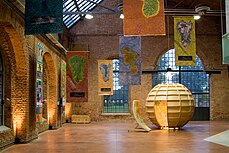
Hannah Wilke (born Arlene Hannah Butter; was an American painter, sculptor, photographer, video artist and performance artist. Wilke's work is known for exploring issues of feminism, sexuality and femininity.

Yvonne Helene Jacquette was an American painter, printmaker, and educator. She was known in particular for her depictions of aerial landscapes, especially her low-altitude and oblique aerial views of cities or towns, often painted using a distinctive, pointillistic technique. Through her marriage with Rudy Burckhardt, she was a member of the Burckhardt family by marriage. Her son is Tom Burckhardt.

The feminist art movement in the United States began in the early 1970s and sought to promote the study, creation, understanding and promotion of women's art. First-generation feminist artists include Judy Chicago, Miriam Schapiro, Suzanne Lacy, Judith Bernstein, Sheila de Bretteville, Mary Beth Edelson, Carolee Schneeman, Rachel Rosenthal, and many other women. They were part of the Feminist art movement in the United States in the early 1970s to develop feminist writing and art. The movement spread quickly through museum protests in both New York and Los Angeles, via an early network called W.E.B. that disseminated news of feminist art activities from 1971 to 1973 in a nationally circulated newsletter, and at conferences such as the West Coast Women's Artists Conference held at California Institute of the Arts and the Conference of Women in the Visual Arts, at the Corcoran School of Art in Washington, D.C..
Joan Snyder is an American painter from New York. She is a MacArthur Fellow, a Guggenheim Fellow, and a National Endowment for the Arts Fellow (1974).
Pattern and Decoration was a United States art movement from the mid-1970s to the early 1980s. The movement has sometimes been referred to as "P&D" or as The New Decorativeness. The movement was championed by the gallery owner Holly Solomon. The movement was the subject of a retrospective exhibition at the Hudson River Museum in 2008.

Janet Fish is a contemporary American realist artist. Through oil painting, lithography, and screenprinting, she explores the interaction of light with everyday objects in the still life genre. Many of her paintings include elements of transparency, reflected light, and multiple overlapping patterns depicted in bold, high color values. She has been credited with revitalizing the still life genre.
Judith E. Stein is a Philadelphia-based art historian and curator, whose academic career has focused on the postwar New York art world. She has written a biography of the art dealer Richard Bellamy, as well as feature articles regarding artists including Jo Baer, Red Grooms, Lester Johnson, Alfred Leslie and Jay Milder.
Harmony Hammond is an American artist, activist, curator, and writer. She was a prominent figure in the founding of the feminist art movement in 1970s New York.
Valerie Jaudon is an American painter commonly associated with various Postminimal practices – the Pattern and Decoration movement of the 1970s, site-specific public art, and new tendencies in abstraction.
Robert Kushner(; born 1949, Pasadena, CA) is an American contemporary painter who is known especially for his involvement in Pattern and Decoration. He has been called "a founder" of that artistic movement. In addition to painting, Kushner creates installations in a variety of mediums, from large-scale public mosaics to delicate paintings on antique book pages.
Amy Goldin was an American art critic who worked from 1965 until 1978. In those thirteen years, she published almost 200 pieces, from single paragraph reviews of current exhibitions, catalog essays, and book reviews. She covered topics that were unconventional at the time: Folk art, African-American art, craft, decoration, graffiti and Islamic art. Her writing appeared regularly in Arts, ARTnews, Artforum, Art Journal, New American Review, International Journal for Aesthetics and Art Criticism, and most frequently in Art in America, where she was a contributing editor.
Dee Shapiro is an American artist and writer associated with the Pattern and Decoration movement.
Cynthia Carlson is an American visual artist, living and working in New York.

Joyce J. Scott is an African-American artist, sculptor, quilter, performance artist, installation artist, print-maker, lecturer and educator. Named a MacArthur Fellow in 2016, and a Smithsonian Visionary Artist in 2019, Scott is best known for her figurative sculptures and jewelry using free form, off-loom beadweaving techniques, similar to a peyote stitch. Each piece is often constructed using thousands of glass seed beads or pony beads, and sometimes other found objects or materials such as glass, quilting and leather. In 2018, she was hailed for working in new medium — a mixture of soil, clay, straw, and cement — for a sculpture meant to disintegrate and return to the earth. Scott is influenced by a variety of diverse cultures, including Native American and African traditions, Mexican, Czech, and Russian beadwork, illustration and comic books, and pop culture.
Susan Michod is an American feminist painter who has been at the forefront of the Pattern and Decoration movement since 1969. Her work "consists of monumental paintings [which are] thickly painted, torn, collaged, spattered, sponged, sprinkled with glitter and infused with a spirit of love of nature and art," the art critic Sue Taylor has written.

Nade Haley was an American visual artist whose work has been exhibited at numerous museums and galleries, and is held in public and private collections. After relocating from Washington DC, Haley lived and kept studios in New York City and in Cape Breton, Nova Scotia.
Joyce Reopel (1933–2019) was an American painter, draughtswoman and sculptor who worked in pencil, aquatint, silver- and goldpoint, and an array of old master media. A Boris Mirski Gallery veteran, from 1959 to 1966, she was known for her refined skills and virtuosity. She was also one of very few women in the early group of Boston artists that included fellow artist and husband Mel Zabarsky, Hyman Bloom, Barbara Swan, Jack Levine, Marianna Pineda, Harold Tovish and others who helped overcome Boston's conservative distaste for the avant-garde, occasionally female, and often Jewish artists later classified as Boston expressionists. Unique to New England, Boston Expressionism has had lasting local and national influence, and is now in its third generation.
Nancy Princenthal is an American art historian, writer, and author. She is based in Brooklyn, New York.

Arlene Slavin is a painter, sculptor, and a print-maker whose practice also includes large-scale public art commissions. Slavin is a 1977 National Endowment for the Arts Grant recipient.












